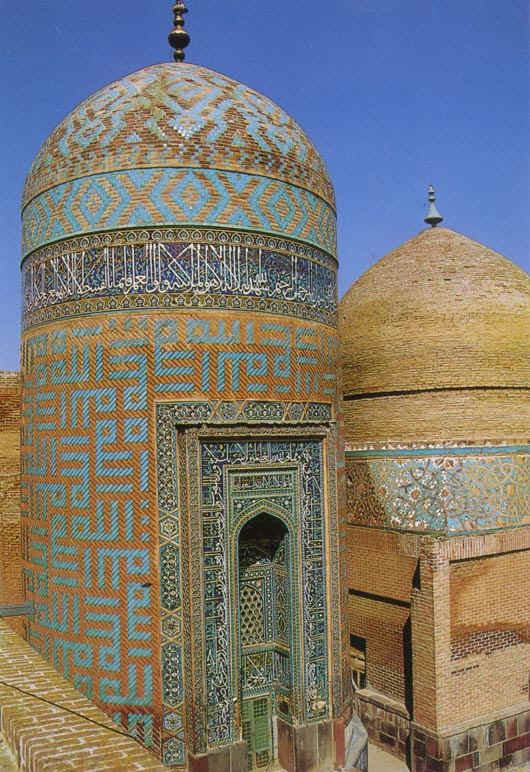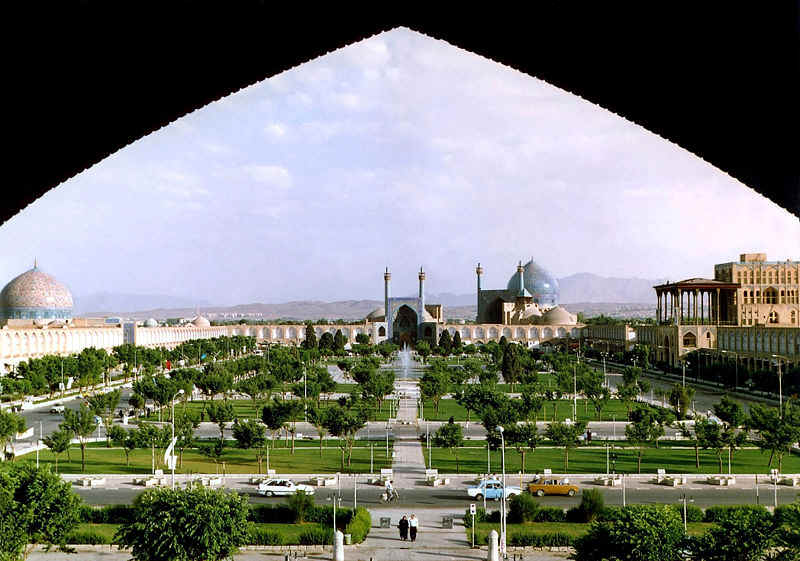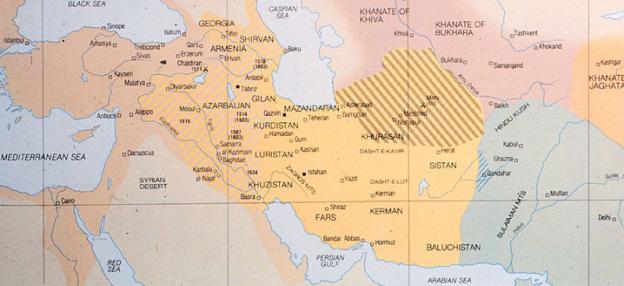Chapter 13 Transformations in Asia and Africa on the Eve of European Overseas Expansion
Section 2
Safavid Persia
At roughly the same time the Ottoman Empire was being developed, a new dynasty of rulers, known as the Safavids, gained power over the Iranian plateau. This dynasty did not last nearly as long nor control as much territory as its Ottoman rival, but the Safavids did succeed in blending together Persian cultural traditions and Shi’a Islam in ways that would lay the foundation for the emergence of Iran as a nation-state. At its peak, Safavid Persia was a significant world power with a brilliant civilization much admired by its neighbors.
Origins of the
Safavids
The Safavid family began its rise to power in Iran in the last half of the 1200s. The founder of the family, Safi al-Din, lived near the town of Ardabil in northwestern Iran. In the turmoil and destruction that marked the aftermath of the Mongol invasion, Safi al-Din had become disillusioned with the world around him and had turned instead to the ascetic and mystic path of the Sufi. In search of spiritual truth, he attached himself to one of the most famous Sufis of the time, Shaykh Zahid, who also lived in the area of Gilan near the Caspian Sea.

The tomb of Sheikh Safi-ad-Din-e-Ardabili, taken from http://www.kassa.ir/Tourism/Ardabil.htm
Safi al-Din remained Shaykh Zahid’s pupil for some twenty-five years. According to tradition, the old Shaykh saw great promise in his pupil, and signs of extraordinary spiritual power. Whether true or not, eventually the old shaykh gave his own daughter to Safi al-Din as his wife. When Shaykh Zahid died in 13012, Safi al-Din also succeeded him as the head of his Sufi tariqa. Thereafter, every head of the Safavid family was also recognized as the murshid, or “perfect spiritual guide” of the order.
Although Safi al-Din had turned to Sufism as a means of withdrawing from the world, his successors soon saw religion as a reason to involve themselves in the world. Aided by a chief deputy and an elite group of advisors, the Safavid murshids began to direct a secret organization of missionaries who spread propaganda and Safavid doctrines on behalf of the family as far away as Syria and Herat. In their most extreme form, these doctrines portrayed the Safavid murshids as an incarnation of God, a divine being worthy of worship and veneration. Increasingly, the Safavids identified themselves with Shi’ism.
The Safavids were particularly successful in winning the support of
the Turkomans and Mongols who had flooded into the region with the Il-Khanids
and Timur. Many stories tell of how these nomads were impressed and awed
by the spiritual powers of the Safavids. Although no doubt legendary, such
stories probably reflect the effect the Safavid murshids had on the rather
superstitious and impressionable Turko-Mongol tribesmen and even some
Turko-Mongol rulers.
The Safavids began their rise to power as spiritual leaders of a Sufi
order in Iran.
The area in yellow shows the region of Persia securely held by the Safavids in the 16th and 17th centuries. The striped areas represent regions that were less secure including Azarbaijan.[5]
The Rise of
the Safavid Empire
In the last half of the 1400s, the Safavid movement took on a decidedly different character as its leaders began to transform it from a religious movement into a political state. The basis of this effort was the military power of the Safavids’ most loyal Turkoman tribal followers. These followers were known as the Kizilbash, or “Red Heads,” because they wore distinctive red hats with twelve pleats in memory of the 12 Shi’ite imams from whom the Safavids had now begun to claim descent.
Even with the support of the Kizilbash, however, Junayd and Haydar, the first two leaders to attempt the creation of a Safavid state, were completely unsuccessful. The local rulers and tribesmen of the region they were trying to conquer killed first Junayd and then Haydar. Haydar’s defeat and death in 1488 left the Safavid movement temporarily without a leader since his three young sons were imprisoned. The fate of one of the boys is unknown, the second was eventually murdered, and the third, Isma’il, went into hiding in a remote area of Gilan in 1494.
Shah Isma’il.
Despite these disasters, the Safavid religious organization and propaganda
machine was still intact and effective. Moreover, the hard core of
Kizilbash supporters did not view the Safavid leader as simply the head of
a Sufi order or the representative of a Shi’ite imam. In the extreme
form of Shi’ism to which they adhered, he was in fact regarded as an
incarnation of God, a divine being worthy of worship and veneration. They
were absolutely loyal and remained eager to fight on his behalf. As one
contemporary European traveler in Persia wrote:
“This Sophi [Isma’il]
is loved and reverenced by his people as a god, and especially by his
soldiers, many of whom enter battle without armour, expecting their master
Ismael to watch over them in the fight. . . . The name of God is forgotten
throughout Persia and only that of Ismael is remembered.” [6]
In 1499, at the age of 13, Isma’il came out of hiding. Almost immediately an army of some 7,000 Kizilbash rallied around him. This time, circumstances were more favorable for the Safavid cause and Isma’il’s forces won victory after victory. In 1501 they occupied Tabriz, the most important city in northwest Iran. Tabriz became the first capital of a Safavid state as Isma’il took the ancient Persian title of Shah-in-Shah, King of kings.
Safavid
religious policy. Isma’il’s first act as Shah was to proclaim that
the official religion of his kingdom would be Shi’ism. Since most of his
subjects were Sunnis, Isma’il’s own advisers urged him to be cautious
about this policy. Ignoring them, instead he threatened to kill anyone who
opposed it and ordered the forcible conversion of the population:
“I am committed to this action; God and the Immaculate Imams are with me, and I fear no one; by God’s help, if the people utter one word of protest, I will draw the sword and leave not one of them alive.”[7]
In fact, Isma’il’s policy was potentially shrewd. Veneration of ‘Ali and respect for his descendants ran very strong in Muslim popular religion, even in Sunni communities. However many Sunnis there were in Isma’il’s realm, there were also many Shi’as. Moreover, by openly championing Shi’ism, Isma’il might attract potential supporters like the Turkomans in eastern Anatolia to the Safavid cause. Not least, Shi’ism provided Isma’il a means of appealing to the sentiments of the general Persian population. With the people on his side his power would no longer solely depend on the Kizilbash.
To reinforce their authority, the Safavids vigorously encouraged the idea that ‘Ali’s son Husayn had married the daughter of the last shah of Iran, and that the later imams—and the Safavid family itself—descended from this line. Thus, they sought to establish Shi’a rule and at the same time restore the ancient Persian monarchy.
This blending of Persian tradition and Shi’i religion gave the Safavid state a unique identity that became the bedrock of national culture in modern Iran. At the same time, it sharply distinguished the Safavid state from that of its Sunni rivals, notably the Ottomans to the west and the Özbeks in the east. The injection of the Sunni-Shi’a schism into the political struggles of the time, however, thoroughly embittered relations between the two branches of Islam and led to bloody persecutions on both sides.
Rivalry with
the Ottomans. Over the next few years, Isma’il’s army won many
more victories, from Baghdad and the Shi’ite shrines of Iraq to Marv and
Central Asia. His obviously expansionist ambitions, coupled with his
Shi’ite and anti-Sunni policies, put the Safavid ruler on a collision
course with the Sunni Ottomans to his west and the Sunni Özbek tribesmen
to his east. In 1510, Isma’il defeated the Özbek army and sent the head
of the Özbek khan, stuffed with straw, to the Ottoman sultan—one of
many calculated insults which, along with some offensive poetry and
attempts to stir up revolts among the Turkomans of Anatolia, led Sultan
Selim finally to attack the Safavids.
The Battle of Chaldiran. Isma’il’s success did not last long. A new Özbek army routed the Safavid forces in Central Asia, beginning a long and inconclusive struggle for control of the region. Much more serious was the defeat inflicted on the Safavids by Selim at the Battle of Chaldiran in 1514. The Ottoman victory was due to many advantages—superior numbers, better preparation and tactics, the crack Janissary troops, and above all the Ottoman’s use of muskets and artillery. The enthusiasm and fearlessness of the Kizilbash cavalry was no match for the massed firepower of the Ottomans. The Safavid army was cut to pieces and lost many of its top officers—but the greatest casualty may well have been the myth of Isma’il’s divinity and invincibility. The Kizilbash in particular seem to have become disillusioned.
After
Chaldiran the Safavid state faced serious problems. Isma’il himself
became depressed and lost interest in state affairs, which he began to
leave in the hands of ministers. He died in 1524, at the age of only
thirty-six. His son Tahmasp, who was too young to rule on his own,
succeeded him. Although eventually Tahmasp would reign for over fifty
years, in the beginning his advisors confronted the task of maintaining a
state that had foreign enemies on most borders, divisive internal
competition between the Kizilbash soldiers and Persian bureaucrats, and
the difficult task of spreading the official Shi’ite state religion.
Safavid recovery. Despite these challenges, the Safavid state did survive. Eventually, Shah Tahmasp asserted his own authority and began dealing with these difficulties. Under Tahmasp, the Safavid army began making better use of gunpowder weapons, both muskets and artillery. Tahmasp could not defeat either the Ottomans or Özbeks, but he was able to resist them fairly effectively. In 1548, he moved his capital from Tabriz to Qazvin, which was both more secure and, as a Persian city, more independent of Turkoman influence.
Tahmasp also compensated for his loss of territory to the Ottomans
by expanding into the Caucasus. For the first time, this gave the Safavids
control over a non-Persian and non-Muslim population—mostly Armenians
and Georgians. Some now entered the service of the Safavids as vassals,
and large numbers were deported to Iran as state slaves. The Caucasus
became the Safavid equivalent of the Balkans for the Ottomans. Just as the
Ottomans had increased their military strength and the authority of the
central government through the devshirme, the Safavids now created their
own institutional slave establishment as a third base of support alongside
the Kizilbash and the Persian people.
The Safavid adoption of Shi’ism as their state religion threatened
their Sunni neighbors and led to conflict, defeat, and recovery.
Shah ‘Abbas and the Height of Safavid Arts and Culture
The death of Tahmasp in 1576 was followed by a period of disturbances and instability which came to an end with the accession of Shah ‘Abbas, the greatest of all the Safavid rulers, in 1588. Shah ‘Abbas saw clearly that the Kizilbash who had brought the dynasty to power were becoming disloyal and a danger to the authority of the crown. As he sought ways to limit their power, he attracted new Turkoman supporters, loyal to him personally and known not by tribal affiliations but as “Shah Lovers”.
‘Abbas also reorganized and expanded his army. Copying the Ottomans, he transformed the traditional Safavid army made up of tribesmen into a powerful standing army composed of troops loyal only to him. He also armed his new army with modern gunpowder weapons. For example, he created a royal bodyguard and cavalry units composed completely of elite slave troops armed with muskets. To further offset his dependence on the Kizilbash, he added Persian musketeers and an artillery corps to the army. With this new reliable standing army, ‘Abbas was able to centralize the administration of the country and regain control of the tax revenues which had been allowed to revert to local governors and landowners.
Once ‘Abbas was firmly in control, he turned to his foreign
problems, beginning with the Özbeks. In 1598, he defeated the Özbeks
outside Herat and effectively pacified that border. This freed him to deal
with the Ottomans. In a series of battles between 1603 and 1607, Abbas
recovered much of the territory that had been lost to the Ottomans. In
1623, he invaded Iraq, recaptured Baghdad, and held it against an Ottoman
counter-attack. This campaign reinforced the Shah’s legitimacy as a
Shi’i ruler since it restored the Shi’a holy shrines in Iraq to
Persian control.
Economic developments. In addition to his military successes, Shah ‘Abbas also instituted major development plans in the empire’s economy. In particular he encouraged both manufacturing and trade. In an effort to improve the production of glazed tilework, for example, he imported Chinese craftsmen. In addition to passing on their skills to Iranian artisans, these craftsmen also provided the tiles that adorned many Safavid buildings. They also contributed to a thriving export trade with Europe.
‘Abbas was also responsible for transforming the production of
carpets in Iran from a home industry into a major national industry. In
one city, for example, over 25,000 weavers worked in factories that
produced not only carpets but also many other woven goods such as silks,
velvets, and brocades. ‘Abbas encouraged these industries to provide
goods for overseas sale.
Imperial Isfahan. In 1597, Shah ‘Abbas decided to move his capital from Qazvin to Isfahan, near the center of the Iranian plateau. Isfahan was an ancient city and had been greatly favored by the Seljuks, but under ‘Abbas it was transformed into one of the most magnificent and beautiful cities in the world, the supreme expression of Safavid achievements in art and architecture.
In an impressive example of city planning, ‘Abbas concentrated his efforts on the relatively open southern areas of the site. He constructed a long, straight, broad avenue, the Chahar Bagh to link his gardens and palace in the north to the suburbs beyond the Zayandeh Rud river in the south. The center of his city was an immense maydan or public square, known as the Maydan-i Shah, the Shah's plaza, or Naqsh-i Jahan, "image of the world" - a huge rectangular park large enough for polo games and flanked by an arcade of shops and the great Ali Qapu palace. A monumental gateway at the north led into the royal bazaar, and another at the south gave access to the Masjid-i Shah, or “Shah’s Mosque.” The mosque, with its huge dimensions, colorful tiles, imposing dome, and unique plan, is widely regarded as the most impressive mosque in Persia.

Shah Abbas's great maydan at the heart of imperial Isfahan, looking from the north entrance south to the entrance of the great mosque, Masjid-i Shah, with the Ali Qapu palace on the western side of the square (right). Taken from http://www.google.com/imgres?imgurl=http://www.muslims.eu/images/isfahan.jpg
Under
Shah ‘Abbas, Isfahan grew into a city of nearly 750,000 people. In
addition to over a hundred mosques, the city boasted nearly 50 religious
schools for training the ulama, and several hundred public baths. Parks,
public gardens, restaurants, and splendid caravanserais, or hotels, made
Isfahan one of the great cities of the world in the 1600s.
Under Shah Abbas, the Safavids reached the height of their power.
